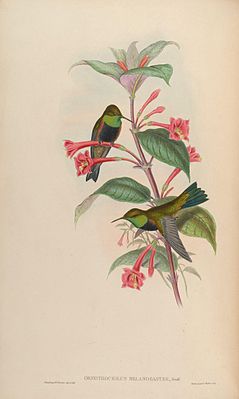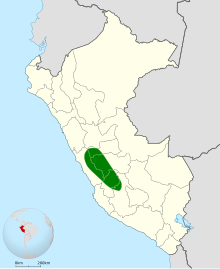Black-breasted Andean Hummingbird
| Black-breasted Andean Hummingbird | ||||||||||||
|---|---|---|---|---|---|---|---|---|---|---|---|---|

Black-breasted Andean Hummingbird illustrated by John Gould and Henry Constantine Richter |
||||||||||||
| Systematics | ||||||||||||
|
||||||||||||
| Scientific name | ||||||||||||
| Oreotrochilus melanogaster | ||||||||||||
| Gould , 1847 |
The black-breasted Andean hummingbird ( Oreotrochilus melanogaster ) is a species of bird in the hummingbird family (Trochilidae) that is endemic to Peru . The IUCN assesses the population as Least Concern . The species is monotypical .
features
The black-breasted Andean hummingbird reaches a body length of about 13 to 14 cm with a weight of about 8.4 g. The slightly curved beak is black. The upper side of the male is gray-brown and slightly darker than that of the Estella Andean hummingbird . The throat collar shimmers emerald green, the rest of the underside is black. The flanks are monotonous grayish brown. The blue-black tail is slightly forked. The female is gray-brown throughout, but clearly lighter on the underside. The tail is greenish-black. The white base of the control feathers as in the female Estella Andean hummingbird is missing.
Behavior and nutrition
In the Junín region , the Andean black-breasted hummingbird gets its nectar mainly from the flowers of the Chuquiraga spinosa scrub, but in the Huancavelica region it also visits the flowers of cacti. Depending on the availability of food, it flies regularly as a trapliner in quick succession to very specific, scattered flowers. Here he mainly visits red flowers such as Caiophora , Castilleja and Puya . Occasionally he also visits Cassia and eucalyptus . He chases insects high in the air.
Vocalizations
The song of the black-breasted Andean hummingbird has been little explored. It gives off a squeaky twittering that rises and falls during the hunt.
Reproduction
The breeding season of the black-breasted Andean hummingbird is from December to April. He builds his nest on protected rocks or on the edge of the roofs of farmhouses. It is a large cup-like nest that is attached to the carrier material. A clutch consists of two white eggs. Presumably it has its first brood in its second year of life.
distribution and habitat
The black-breasted Andean hummingbird prefers the Puna slopes with dense Chuquiragua spinosa vegetation and cacti with a deep substructure, as well as rocky areas where herbs are usually abundant in sheltered niches. He often moves in gardens, but has also been observed at altitudes of 3500 to 4000 meters on Puya raimondii . In addition to the Junín and Huancavelica regions, it occurs in the adjacent mountains of the Ancash , Lima , Pasco and Ayacucho regions .
migration
Even if the black-breasted Andean hummingbird is a resident bird in the Altiplano of Junín , it seems to leave the puna of Huancavelica when the cacti do not bloom.
Etymology and history of research
The first description of the black breast Andean hummingbirds in 1847 by John Gould under the scientific name Oreotrochilus melanogaster . He got the type specimen from John Leadbeater . With the species Gould introduced the new genus Oreotrochilus . The name is derived from the Greek words "oros ὄρος " for "mountain" and "trochilus τρόχιλος " for "hummingbird". The term »Trochilus«, which Carl von Linné used for a new genre in 1758, is historically somewhat problematic. This term was already used by Aristotle for a bird that visits the mouth of a crocodile without being injured or even eaten by it. Étienne Geoffroy Saint-Hilaire suspected that Aristotle used it to describe the crocodile guardian ( Pluvianus aegyptius ). The species name "melanogaster" is derived from the Greek "melas, melanos μελας, μελανος " for "black" and "gastēr, gastros γαστηρ, γαστρος " for "belly".
literature
- Jon Fjeldså, Peter Boesman in: Josep del Hoyo , Andrew Elliott, Jordi Sargatal , David Andrew Christie , Eduardo de Juana: Black-breasted Hillstar (Oreotrochilus melanogaster) in Handbook of the Birds of the World Alive . Lynx Edicions, Barcelona.
- James A. Jobling: Helm Dictionary of Scientific Bird Names . Christopher Helm, London 2010, ISBN 978-1-4081-2501-4 .
- John Gould: Drafts for an arrangement of the Trochilidae, with descriptions of some species . In: Proceedings of the Zoological Society of London . tape 15 , no. 168 , 1847, pp. 7-11 ( biodiversitylibrary.org ).
- Carl von Linné: Systema Naturae per Regna Tria Naturae, Secundum Classes, Ordines, Genera, Species, Cum Characteribus, Differentiis, Synonymis, Locis . 10th edition. tape 1 . Imprensis Direct Laurentii Salvii, Stockholm 1758 ( biodiversitylibrary.org ).
- Étienne Geoffroy Saint-Hilaire: Mémoire sur deux espèces d'animaux nommés Trochilus et Bdella par Hérodote, leur guerre, et la part qu'y prend le Crocodile . In: Mémoires du Muséum d'histoire naturelle . tape 15 , 1827, pp. 459-474 ( biodiversitylibrary.org ).
Web links
- Oreotrochilus melanogaster inthe IUCN Red List of Threatened Species 2019.2. Listed by: BirdLife International, 2016. Retrieved November 7, 2019.
- BirdLife International: Species Factsheet - Black-breasted Hillstar ( Oreotrochilus melanogaster ) . Retrieved November 7, 2019.
- Videos, photos and sound recordings of Black-breasted Hillstar (Oreotrochilus melanogaster) in the Internet Bird Collection
- Black-breasted Andean Hummingbird ( Oreotrochilus melanogaster ) at Avibase; accessed on November 7, 2019.
- Oreotrochilus melanogaster in the Integrated Taxonomic Information System (ITIS). Retrieved November 7, 2019.
- xeno-canto: Sound recordings - Black-breasted Andean hummingbird ( Oreotrochilus melanogaster )
- Black-breasted Hillstar (Oreotrochilus melanogaster) in the Encyclopedia of Life . Retrieved November 7, 2019.
Individual evidence
Remarks
- ↑ In addition to the Black-breasted Andes Hummingbird ( Oreotrochilus melanogaster ), he also ordered the white edge Andes Hummingbird ( Oreotrochilus leucopleurus Gould , 1847), the Ecuadorian Hillstar ( Oreotrochilus chimborazo ( Delattre & Bourcier , 1846)), the wedge-tailed hillstar ( Oreotrochilus adela ( d 'Orbigny & Lafresnaye , 1839)) and the Estella Andean hummingbird ( Oreotrochilus estella ( d'Orbigny & Lafresnaye , 1839)).
